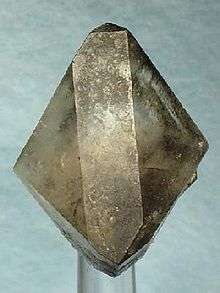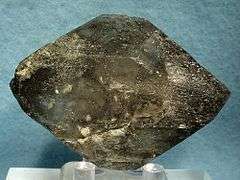Blödite
| Blödite | |
|---|---|
|
Doubly terminated blödite crystal from Soda Lake, San Luis Obispo County, California (size: 7.0 x 4.8 x 1.9 cm) | |
| General | |
| Category | Sulfate minerals |
| Formula (repeating unit) | Na2Mg(SO4)2·4H2O |
| Strunz classification | 7.CC.50 |
| Crystal system | Monoclinic |
| Crystal class |
Prismatic (2/m) H-M symbol: (2/m) |
| Space group | P21/a |
| Unit cell |
a = 11.04 Å, b = 8.15 Å, c = 5.49 Å; β = 100.41°; Z = 2 |
| Identification | |
| Color | Colorless, yellow, may be dark gray, bluish green, or reddish due to inclusions |
| Crystal habit | Prismatic to equant crystals, granular, massive |
| Fracture | Conchoidal |
| Tenacity | Brittle |
| Mohs scale hardness | 2.5 - 3 |
| Luster | Vitreous |
| Specific gravity | 2.23 |
| Optical properties | Biaxial (-) |
| Refractive index | nα = 1.483, nβ = 1.486, nγ = 1.487 |
| Birefringence | δ = 0.004 |
| 2V angle | 71° (measured) |
| References | [1][2][3] |
Blödite or bloedite is a hydrated sodium magnesium sulfate mineral with formula: Na2Mg(SO4)2·4H2O. The mineral is clear to yellow in color often darkened by inclusions and forms monoclinic crystals.
Blödite was first described in 1821 for an occurrence in a salt deposit in Ischler Salzberg, Bad Ischl, Gmunden, Austria and named for German mineralogist and chemist Karl August Blöde (1773–1820).[2][3]
It is found worldwide in evaporitic sedimentary environments such as the Great Salt Lake, Utah.
See also
References

Crystal from Soda Lake (size: 2.9 x 2.2 x 1.4 cm)
| Wikimedia Commons has media related to Blödite. |
This article is issued from Wikipedia - version of the 11/22/2016. The text is available under the Creative Commons Attribution/Share Alike but additional terms may apply for the media files.
